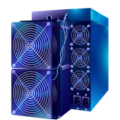Asic Miner Profitability
Our mining profitability calculator helps users quickly pinpoint the most lucrative mining options by delivering real-time data in multiple fiat and cryptocurrency currencies, including USD, EUR, GBP, AED, CAD, AUD, THB, ETH, and BTC. It allows precise electricity cost inputs up to three decimal places for highly accurate profit estimations. Users can access a clear overview of top-performing miners, algorithm-specific performance tables, and visually organized listings of mineable coins with recognizable cryptocurrency icons, simplifying decisions for maximum returns.
| Model | Hashrate |
Profitability
Profit
|
|---|---|---|
|
IceRiver RX0
260GH/s
|
260 GH/s |
$-0.05/day
|
Our cutting-edge mining calculator offers comprehensive insights across all major cryptocurrency algorithms, helping users easily identify the most profitable options for their specific hardware. The algorithm data is continuously refreshed to keep pace with the dynamic crypto mining industry, providing accurate evaluations based on real-time profitability statistics and overall market activity. This empowers users to make well-informed choices that reflect the latest mining conditions and algorithm performance.
Bitcoin Mining Difficulty
Monitor the latest Bitcoin network difficulty metrics in real time, including block times & estimated time until the next difficulty adjustment.
Progress
Current progress:
61.51 %
Remaining Block
Blocks Left:
776
Remaining Time
Time Left:
~ 5 days 1 hours
Next Change
Upcoming change:
6.9 %
Block Time
Current Block Time:
9.4 minutes
What is SHA512256d algorithm?
Why Should You Rely on Our Profit Calculator for Accurate Mining Insights?
In the hush of computation, SHA512256d moves like a second shadow that seals what it touches before it can be altered, because it runs SHA-512 twice and then keeps a compact 256-bit digest. This two-pass path breaks the usual length-extension tricks and dulls collision attempts, which raises the bar for attackers who stalk preimages and near-misses. The result is a hash that fortifies block integrity and narrows the window for tampering. It runs fast on 64-bit architectures that favor SHA-512’s wide lanes, yet its 256-bit output stays friendly to common mining pipelines. Radiant (RXD) uses this design to bind scalability with decentralization, as the algorithm pairs well with network growth and stable consensus. The structure welcomes ASICs, which handle the repeated compression with steady efficiency and low variance. This choice limits GPU favoritism and encourages hardware built for the task, which improves throughput and predictability. ASIC adoption also reduces stale work and smooths propagation, which supports a resilient mempool and timely block finalization. Practical gains show up in machines like the IceRiver RX0, which reaches about 260 Gh/s at roughly 100 W, yielding around 0.385 J/Gh in energy use. Such efficiency matters because power dominates mining costs and constrains fleet scaling. The denser computation from double SHA-512 adds friction for adversaries while keeping verification simple for full nodes. By closing off length-extension avenues, it helps ensure that padded messages cannot be stretched into fraudulent siblings. Miners can plan with profit calculators that fold in hashrate, energy draw, efficiency, pool fees, difficulty, block rewards, and uptime to model real-time outcomes. This planning reduces exposure to sudden difficulty swings and network luck streaks. In daily operation, SHA512256d delivers high throughput, predictable latency, and a small attack surface, so transactions pass through a corridor guarded by hard mathematics rather than hope.
Latest ASIC Miners
Check out the latest ASIC miners added to our site. These are the newest listings, featuring the most recent models.
V3
Nerdminer
AE3
IceRiver
Antminer L11 Hyd 2U
Bitmain
Why ASIC Mining?
The Advantages of ASIC Mining Compared to Other Mining Types
ASIC (Application-Specific Integrated Circuit) mining involves specialized hardware designed exclusively for mining cryptocurrencies like Bitcoin, offering unmatched efficiency and performance. Unlike general-purpose GPUs, ASICs are optimized for specific algorithms, delivering significantly higher hashrates while consuming less power per hash. This makes them far superior for mining tasks, as they maximize profitability by reducing electricity costs and increasing mining output. ASIC miners are purpose-built, providing stability and reliability in high-demand mining environments, unlike GPUs which are prone to overheating and wear during prolonged use. Their compact design also allows for easier scalability in large mining operations. By focusing solely on mining, ASICs eliminate the overhead of multi-purpose computing, resulting in faster block-solving times. This efficiency translates to higher rewards, making ASICs the preferred choice for serious miners aiming to stay competitive in the cryptocurrency market. In contrast, GPU mining, while versatile, cannot match the raw power and cost-effectiveness of ASICs for dedicated mining tasks.
Optimized for Mining
Energy Efficient
Reliable & Stable
Scalable
More about the SHA512256d algorithm
See how our profit calculator delivers accurate, real-time mining insights, helping miners make informed decisions.
SHA512256d applies the SHA-512 compression function twice and then emits a compact 256-bit digest, pairing the throughput advantages of 64-bit arithmetic with the broad interoperability of a 256-bit hash size; this two-pass design deepens the avalanche effect, raises the computational bar against preimage and second-preimage attempts (about 2^256 for preimage, with collisions bounded by the 2^128 birthday limit for 256-bit outputs), and helps blunt structural shortcut attacks common to single-pass Merkle–Damgård constructions when appropriate initialization and truncation practices are used, so each block header and Merkle root lands with the clean finality of a well-kept ledger line. Radiant (RXD) employs SHA512256d to anchor its proof-of-work, marrying scalability with decentralization by favoring deterministic, verifiable computation that propagates quickly across the network, reducing stale blocks and making history harder to rewrite without a dominant share of hashrate; miners contribute by hashing candidates, validating new blocks, and stitching transactions into tamper-resistant chains that align incentives with security. Because SHA-512’s 64-bit operations map efficiently to modern silicon, the algorithm lends itself to ASIC implementations that deliver high energy efficiency, predictable performance, and reduced variance; for example, hardware like the IceRiver RX0 demonstrates around 260 Gh/s at roughly 100 W, or near 0.385 J/Gh, a figure that helps operators benchmark performance per joule and evaluate thermal headroom, undervolting targets, and cooling strategies to maintain stable uptime. While hobbyists can experiment with CPUs or GPUs to learn the protocol, dedicated ASICs typically secure the network at scale, lowering the cost per hash and concentrating optimization on power delivery, heat dissipation, and pool connectivity to minimize stale shares and orphan risk. In practice, miners gauge viability by modeling hashrate, power draw, uptime, pool fees, network difficulty, block reward schedule, and expected stale rates, adjusting firmware and frequency to find a steady operating point that protects margins while supporting network health. For Radiant, SHA512256d’s 256-bit output integrates cleanly with wallet, node, and Merkle tooling that expect SHA-2–style digests, and the dual-hash path makes opportunistic shortcut attacks less attractive, increasing the work needed for any adversary to fabricate histories or forge proofs-of-work. The result is a chain that remains resilient under load and change-scalable, ASIC-forward, and still open to participation-where the rhythm of hashing and validation works like a quiet, insistent heartbeat, holding space for trust, conflict, and resolution as the ledger grows block by block.
 English
English
 German
German
 Hungarian
Hungarian
 Dutch
Dutch
 Spanish
Spanish
 French
French
 Italian
Italian
 Czech
Czech
 Polish
Polish
 Greek
Greek



















